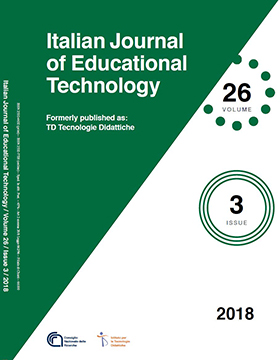VALUTAZIONE TRA PARI ONLINE PER MIGLIORARE I RISULTATI DELL’APPRENDIMENTO E LE SOFT SKILL DEGLI STUDENTI
Contenuto principale dell'articolo
Abstract
Nel contesto universitario il principale obiettivo è garantire una didattica innovativa che veda sempre più lo studente come parte attiva nel processo formativo, favorendo il miglioramento degli apprendimenti in termini di conoscenze e di soft skills. L’utilizzo delle tecnologie online permette di supportare ed innovare le lezioni frontali, anche risolvendo i problemi di mancanza di tempo e spazio connessi con la didattica convenzionale. Per raggiungere i suddetti obiettivi, per il secondo anno consecutivo, grazie all’utilizzo delle tecnologie digitali, abbiamo inserito all’interno del percorso laboratoriale online di Genomica l’attività collaborativa di peer assessment, come processo valutativo con funzione formativa. Questa procedura sperimentale è stata interamente condotta online, utilizzando la piattaforma e-learning Moodle. I risultati del presente lavoro si basano sull’analisi qualitativa e quantitativa del processo di peer assessment e di un questionario sulla percezione soggettiva degli studenti relativa a tale attività collaborativa.
Dettagli dell'articolo
Gli autori che pubblicano su questa rivista accettano le seguenti condizioni:
- Gli autori mantengono i diritti sulla loro opera e cedono alla rivista il diritto di prima pubblicazione dell'opera, contemporaneamente licenziata sotto una Licenza Creative Commons CC BY 4.0 Attribution 4.0 International License.
- Gli autori possono aderire ad altri accordi di licenza non esclusiva per la distribuzione della versione dell'opera pubblicata (es. depositarla in un archivio istituzionale o pubblicarla in una monografia), a patto di indicare che la prima pubblicazione è avvenuta su questa rivista.
- Gli autori possono diffondere la loro opera online (es. in repository istituzionali o nel loro sito web) prima e durante il processo di submission, poiché può portare a scambi produttivi e aumentare le citazioni dell'opera pubblicata (Vedi The effect of Open Access).
Riferimenti bibliografici
Airasian, P., & Russell, M. (2008). Classroom assessment: concepts and applications. Boston, MA, USA: McGraw-Hill Higher Education.
Amendola, D., & Miceli, C. (2016). Online physics laboratory for university courses. Journal of E-learning and Knowledge Society, 12(3).
Aquario, D., & Grion, V. (2017). Valutazione per l’apprendimento: autovalutazione e valutazione fra pari in alcuni corsi dell’Università di Padova. In E. Felisatti, A. Serbati (Eds.), Sviluppare la professionalità docente e innovare la didattica universitaria. Milano, IT: Franco Angeli.
Bangert-Drowns, R., Kulik, C. L. C., Kulik, J. A., & Morgan, M. (1991). The instructional effect of feedback in test-like events. Assessment of Educational research, 61, 213-238. doi:10.3102/00346543061002213
Bevitt, S. (2015). Assessment innovation and student experience: a new assessment challenge and call for a multi-perspective approach to assessment research. Assessment & Evaluation in Higher Education, 40(1), 103–119. doi:10.1080/02602938.2014.890170
Chao, I. T., Saj, T., & Hamilton, D. (2010). Using collaborative course development to achieve online course quality standards. International review of research in open and distance learning, 11(3). Retrieved from http://www.irrodl.org/index.php/irrodl/article/view/912/1644
Gibbs, G., & Simpson, C. (2004). Conditions under which assessment supports students’ learning. Learning and Teaching in Higher, 1, 3-31. Retrieved from http://eprints.glos.ac.uk/3609/
Grion, V., Serbati, A., Tino, C., & Nicol, D. (2017). Ripensare la teoria della valutazione e dell’apprendimento all’università: un modello per implementare pratiche di peer review. Italian Journal of Educational Research, 19. Retrieved from http://ojs.pensamultimedia.it/index.php/sird/article/view/2554
Guilford, W. (2001). Teaching peer review and the process of scientific writing. Advances in Physiology Education, 25, 167-175. doi:10.1152/advances.2001.25.3.167
Hafner, J., & Hafner, P. (2010). Quantitative analysis of the rubric as an assessment tool: an empirical study of student peer‐group rating. International Journal of Science Education, 25(12), 1509-1528. doi: 10.1080/0950069022000038268
Hanrahan, S., & Isaac, G. (2010). Assessing self- and peer-assessment: The students' views. Higher Education Research & Development, 20(1), 53-70. doi:10.1080/07294360123776
Hongli, L., Yao, X., Xiaojiao, Z., Mindy, L. K., Youngsun, L., Kyung, S. C., & Hoi, K. S. (2015). Peer assessment in the digital age: a meta-analysis comparing peer and teacher ratings. Assessment & Evaluation in Higher Education, 41(2), 245-264. doi:10.1080/02602938.2014.999746
Kreber, C., Anderson, C., Entwhistle, N., & McArthur, J. (2014). Advances and innovations in university assessment and feedback. Edinburgh, UK: Edinburgh University Press.
Lan, L., & Fei, G. (2015). The effect of peer assessment on project performance of students at different learning levels. Assessment & Evaluation in Higher Education, 41(6), 885-900. doi: 10.1080/02602938.2015.1048185
Landry, A., Jacobs, S., & Newton, G. (2015). Effective use of peer assessment in writing assignment: a case study. International Journal of Higher Education, 4(1), 38-51. doi:10.5430/ijhe.v4n1p38
Li, L. (2011). How do students of diverse achievement levels benefit from peer assessment?. International Journal for the Scholarship of Teaching and Learning, 5(2). doi: 10.20429/ijsotl.2011.050214
Likert, R. (1932). A technique for the measurement of attitudes. New York archives of Psychology, 22(140), 5-55.
Mulder, R. A., Pierce, J.M., & Baik, C. (2014). Peer review in higher education: Student perception before and after participation. Active Learning in Higher Education, 15(2). doi:10.1177/1469787414527391
Nicol, D., Thomson, A., & Breslin, C. (2013). Rethinking feedback practices in higher education: A peer review perspective. Assessment & Evaluation in Higher Education, 39(1), 102-122. doi: 10.1080/02602938.2013.795518
Persico, D., Pozzi, F., & Sarti, L. (2009). Fostering collaboration in CSCL. In Encyclopedia of Information Communication Technology (pp. 335-340). Hershey, NY, USA: IGI Global.
Stevens, D.D., & Levi, A.J. (2005). Introduction to rubrics: An assessment tool to save grading time, convey effective feedback and promote student learning. Sterling, VA, USA: Stylus.
Topping, K.J., Smith E.F., Swanson, I., & Elliot, A. (2000). Formative peer assessment of academic writing between post graduate students. Assessment and Evaluation in Higher Education, 25(2), 149-169. doi: 10.1080/713611428
Venables, A., & Summit, R. (2003). Enhancing scientific essay writing using peer assessment. Innovation in Education and Teaching International, 40, 281-290. doi:10.1080/1470329032000103816

